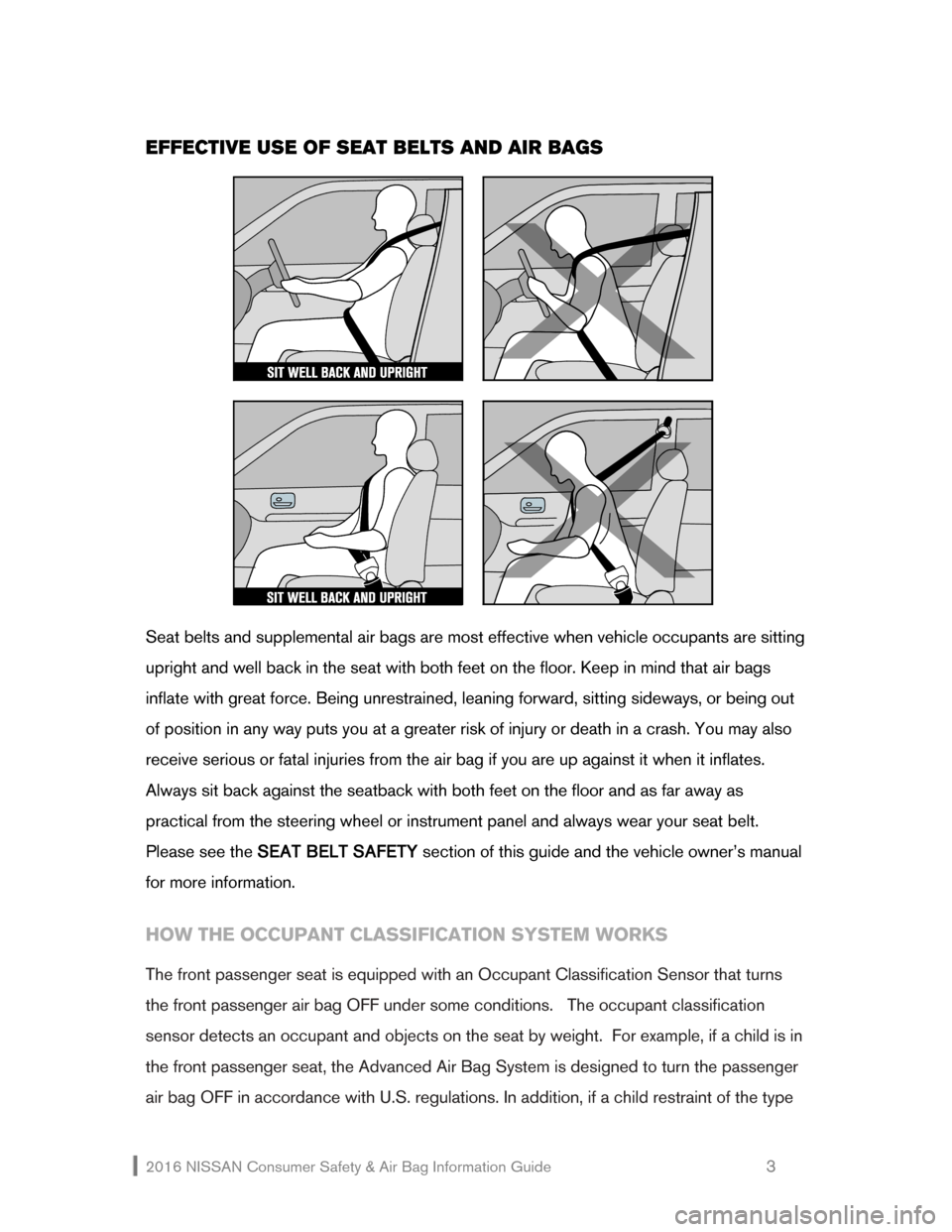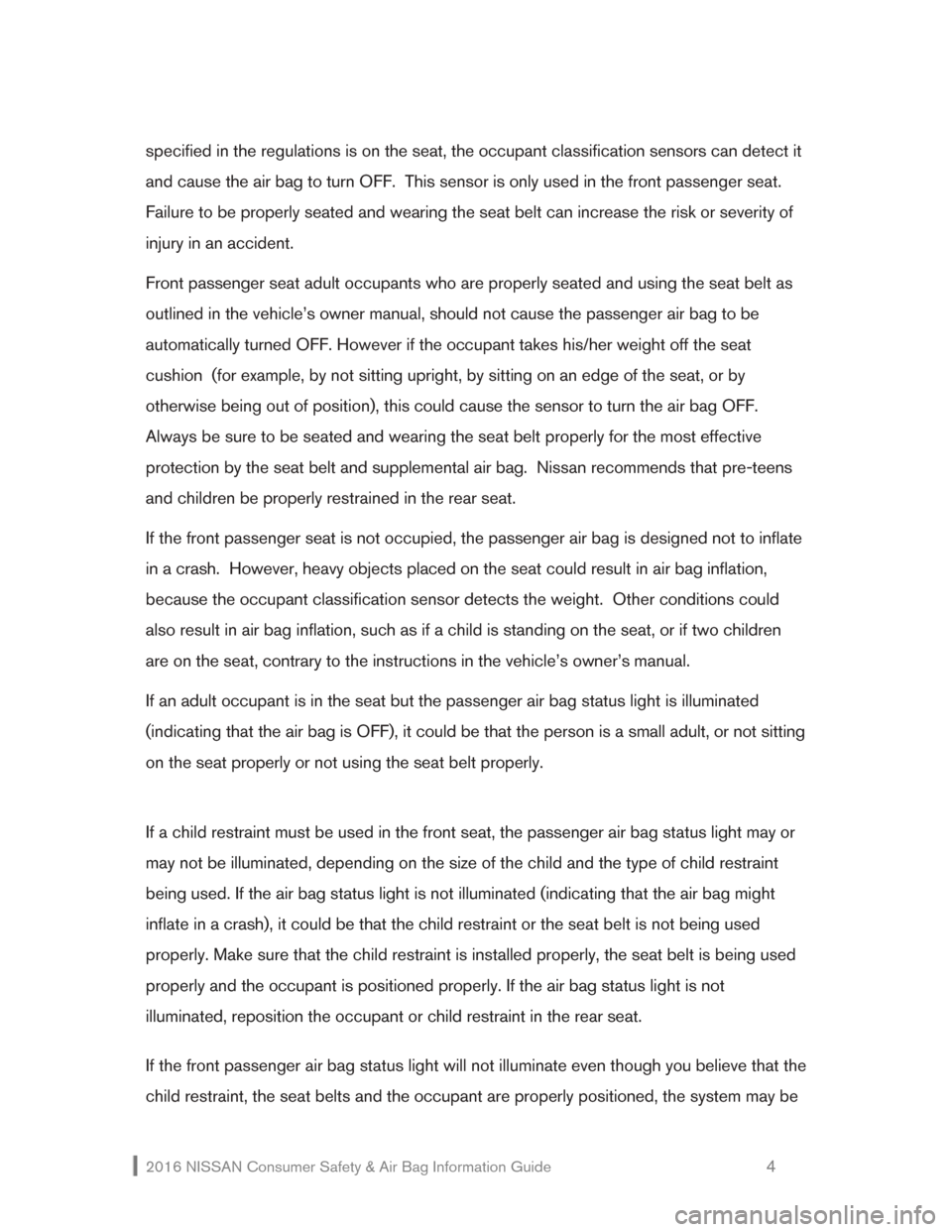2016 NISSAN GT-R sensor
[x] Cancel search: sensorPage 3 of 22

THE NISSAN ADVAN\fED AIR BAG SYSTEM
All 201\b NI\f\fAN vehicles (except for the 201\b NV 1500/2500/3500 , and 201\b Titan XD
Crew Cab *) are equipped with the NI\f\fAN A dvanced A ir Bag \f ystem (AAB\f) for the
driver and front passenger seats. Typically, t his system incorporates dual -stage inflators**,
and monitors information from various crash sensors , the front seat belt buckle sensors,
and the occupant classification sensor.
The front passenger air bag may be automatically turn ed OFF under some conditions,
d epending on the weight detected by sensors in the passenger seat. \fee the vehicle
owner’s manual for more information. If the front passenger air bag is OFF, the front
passenger air bag status light will be illuminated.* **
The front passenger air bag status light does not indicate a malfunction of the front passenger air
bag. If the front passenger air bag status light is illuminated while an adult occupies the seat, the
occupant may need to shift his or her seating posi tion so the system can turn ON the front
passenger air bag and turn OFF the status light. \fee your owner’s manual for proper seating
positions.
Remember, all air bags are supplemental restraint systems. You must properly use seat belts and
child restraints, as explained in the vehicle owner’s manual and your child restraint manufacturer’s
instructions
.
THE MOST IMPORTANT PART OF AN AIR BAG\b YOUR SEAT BELT
Page 4 of 22

EFFE\fTIVE USE OF SEAT BELTS AND AIR BAGS
\feat belts and supplemental air bags are most effective when vehicle occupants are sitting
upright and well back in the seat with both feet on the floor . Keep in mind that air bags
inflate with great force. Being u nrestrained , leaning forward, sitting sideways, or being out
of position in any way puts you at a greater risk of injury or death in a crash. Y ou may also
receive serious or fatal injuries from t he air bag if you are up against it when it inflates.
Always sit back ag ainst the seatback with both feet on the floor and as far away as
practical from the steering wheel or instrument panel and a lways wear your seat belt.
Please see the
\fEAT BELT \fAFETY section of this guide and the vehicle owner’s manual
for more information.
HOW THE O\f\fUPANT \fLASSIFI\fATION SYSTEM WORKS
The front passenger seat is equipped with an Occupant Classification \fensor that turns
the front passenger air bag OFF under some conditions. The occupant classification
sensor detects an occupant and objects on the seat by weight. For example, if a child is in
the front passenger seat, the Advanced Air Bag \fystem is designed to turn the passenger
air bag OFF in accordance with U.\f. regulations. In addition, if a child restraint of the type
201\b NI\f\fAN Consumer \fafety & Air Bag Information Guide 3
Page 5 of 22

specified in the regulations is on the seat, the occupant classification sensors can detect it
and cause the air bag to turn OFF. This sensor is only used in the front passenger seat.
Failure to be properly seated and wearing the seat belt can increase the risk or severity of
injury in an accident.
Front passenger seat adult occupants who are properly seated and using the seat belt as
outlined in the vehicle’s owner manual , should not cause the passenger air bag to be
automatically turned OFF. However if the occupant ta kes his/her weight off the seat
cushion (for example, by not sitting upright, by sitting on an edge of the seat, or by
otherwise being out of position), this could cause the sensor to turn the air bag OFF.
Always be sure to be seated and wearing the seat belt properly for the most effective
protection by the seat belt and supplemental air bag. Nissan recommends that pre- teens
and children be properly restrained in the rear seat.
If the front passenger seat is not occupied, the passenger air bag is designe d not to inflate
in a crash. However, heavy objects placed on the seat could result in air bag inflation,
because the occupant classification sensor detects the weight. Other conditions could
also result in air bag inflation, such as if a child is standi ng on the seat, or if two children
are on the seat, contrary to the instructions in the vehicle’s owner’s manual.
If an adult occupant is in the seat but the passenger air bag status light is illuminated
(indicating that the air bag is OFF), it could be th at the person is a small adult, or not sitting
on the seat properly or not using the seat belt properly.
If a child restraint must be used in the front seat, the passenger air bag status light may or
may not be illuminated, depending on the size of the child and the type of child restraint
being used. If the air bag status light is not illuminated (indicating that the air bag might
inflate in a crash), it could be that the child restraint or the seat belt is not being used
properly. Make sure that the chil d restraint is installed properly, the seat belt is being used
properly and the occupant is positioned properly. If the air bag status light is not
illuminated, reposition the occupant or child restraint in the rear seat.
If the front passenger air bag status light will not illuminate even though you believe that the
child restraint, the seat belts and the occupant are properly positioned, the system may be
201\b NI\f\fAN Consumer \fafety & Air Bag Information Guide 4
Page 8 of 22

If the supplemental air bag warning light in the instrument panel continues to remain ON
or flashes after you start the vehicle, see your Nissan dealer as soon as possible.
After inflation, air bag components are hot, so avoid contact.
Do not place objects on or near the steering wheel or instrument panel where the air
bags inflate.
Never install a rear -facing child restraint in the front passenger seat of a vehicle.
Do not place objects with sharp edges on the seat. Also, do not place heavy objects on
the seat that will leave permanent impressions in the seat. \fuch objects can damage
the seat or the occupant classification sensor. This can affect the opera tion of the air
bag system and result in serious personal injury.
Do not use water or acidic cleaners (hot steam cleaners) on the seat. This can damage
the seat or occupant classification sensors. This can also affect the operation of the air
bag system and result in serious personal injury.
Modifying or tampering with the front passenger seat may result in serious personal
injury. For example, do not change the front seats by placing material on the seat
cushion or by installing additional trim material, such as seat covers, on the seat that are
not specifically designed to assure proper air bag operation. Additionally, do not stow
any objects under the front passenger seat, or on the seat cushion, or store luggage
behind the seat that may contact the seatb ack, or hang heavy objects from the
seatback, or the seatback pocket. \fuch objects may interfere with the proper operation
of the occupant classification sensor.
\fee the vehicle owner’s manual for other important information on safety, seats, seat
belts, and the supplemental restraint system.
WELL BACK AND UPRIGHT
201\b NI\f\fAN Consumer \fafety & Air Bag Information Guide 7